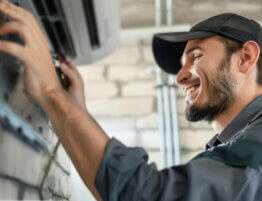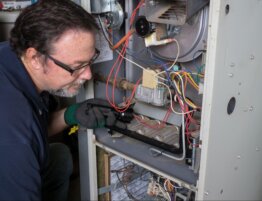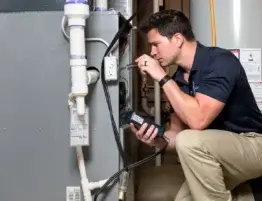
Your thermostat is the command center of your home’s comfort, orchestrating your HVAC system to keep temperatures just right. But when it starts to fail, it can disrupt your entire home, leaving you too hot, too cold, or stuck with soaring energy bills. At My Guys Now, we understand how a faulty thermostat can turn your Cuyahoga County home from cozy to chaotic. So, how do you spot a bad thermostat before it causes bigger problems? In this guide, we’ll cover seven clear signs of thermostat failure, share troubleshooting tips, and explain when to call in our expert team. Let’s get started!
What Are The Signs of a Failing Thermostat
A failing thermostat can show up in subtle or obvious ways, affecting your comfort and your HVAC system’s performance. Here are seven signs to watch for:
HVAC Won’t Turn On: Fails to Start at Set Temperature
Imagine setting your thermostat to a refreshing 72°F on a sweltering day, only to find your air conditioner silent. If your HVAC system doesn’t kick on when the thermostat hits the set temperature, it’s a red flag. This could be due to dead batteries, faulty wiring, or an internal glitch in the thermostat. Sometimes, the thermostat simply isn’t sending the signal to start your HVAC unit.
To check, adjust the temperature a few degrees below (for cooling) or above (for heating) the current room temperature. If nothing happens after a few minutes, your bad thermostat may be to blame.
HVAC Won’t Turn Off: Runs Nonstop Past Set Temperature
Conversely, a thermostat that keeps your HVAC running long after reaching the desired temperature is a problem. If your heater or air conditioner runs nonstop, your home might feel like an icebox in summer or a sauna in winter. This often points to a broken sensor or a stuck relay inside the thermostat, which fails to signal the system to stop.
This not only makes your home uncomfortable but also overworks your HVAC system, potentially leading to wear and tear.
Short-Cycling: Clicks On & Off Rapidly
Short-cycling happens when your HVAC system turns on and off quickly, often with audible clicking from the thermostat. Instead of completing a full heating or cooling cycle, the system starts, stops, and repeats. This could be caused by a thermostat misreading the room temperature or sending erratic signals.
Short-cycling is tough on your HVAC system, stressing components like the compressor and potentially causing premature failure. If you hear rapid on-off cycles, it’s time to investigate.
Uneven Room Temperatures: Hot and Cold Spots in Home
Are some rooms in your home toasty while others feel like a freezer? Uneven temperatures signal a thermostat issue. A working thermostat should ensure consistent temperatures by accurately sensing and controlling your HVAC system. If it’s failing, it might misread the room’s temperature or be poorly placed, like near a sunny window or drafty door.
While duct issues or an undersized HVAC system can also cause uneven temperatures, a bad thermostat is a common culprit. Check for noticeable temperature differences between rooms to narrow it down.
Unresponsive Controls: Buttons or Touchscreen Don’t Respond
Whether you have a basic or smart thermostat, unresponsive controls are a clear sign of trouble. If the buttons don’t work, the touchscreen freezes, or the display is blank, the thermostat may have a software glitch, hardware failure, or dead batteries (in non-smart models). This prevents you from adjusting settings, leaving your HVAC system stuck.
Try pressing buttons or tapping the screen gently. If there’s no response, or the display flickers, your thermostat needs attention.
Higher Energy Bills: Costs Spike Due to Overworking HVAC
Noticing a jump in your energy bills without a change in usage? A malfunctioning thermostat could be forcing your HVAC system to work overtime. For example, a thermostat stuck in “on” mode or misreading temperatures can cause your system to run longer or more often than needed, burning through electricity or gas.
Review your recent bills and compare them to previous months or last year. A significant increase could mean your thermostat is taxing your HVAC system unnecessarily.
Inaccurate Temperature Readings: Thermostat Shows Wrong Temperature
If your thermostat says it’s 68°F but your home feels much warmer or cooler, it’s likely giving inaccurate readings. This happens when the internal sensor fails or if the thermostat is installed in a bad spot, like near a heat source or vent. Incorrect readings confuse the HVAC system, causing it to run when it shouldn’t or stay off when needed.
To test, place a separate thermometer near the thermostat and compare readings after 15-20 minutes. A difference of more than a degree or two suggests a problem.
How To Fix a Broken Thermostat
Before calling a professional or replacing your thermostat, try these DIY steps. They’re straightforward, require minimal tools, and might resolve the issue quickly.
Check and Adjust the Settings
First, confirm your thermostat is in the right mode—“cool” for air conditioning or “heat” for heating—and that the temperature is set correctly. For cooling, set it lower than the room’s current temperature; for heating, set it higher. If you have a programmable or smart thermostat, check the schedule to ensure it’s not following an old program. Switching to manual mode can help you test if the issue is in the settings.
Replace the Batteries
Many thermostats rely on batteries, especially non-smart models. A dim, blank, or erratic display often means the batteries are low. Check your thermostat’s manual (or search the model online) to locate the battery compartment, usually behind the faceplate. Replace with fresh AA or AAA batteries and test again. Even some smart thermostats have backup batteries, so don’t skip this step.
Clean the Thermostat
Dust and debris can build up inside the thermostat, affecting sensors or connections. Turn off power to the thermostat at the circuit breaker for safety. Remove the cover and use a soft brush or compressed air to gently clean the interior, focusing on the sensor and contact points. Avoid water or harsh chemicals, which can damage components. Reassemble and test the air conditioning.
Check the Wire Connections
Loose or corroded wires can disrupt the thermostat’s communication with your HVAC system. With the power off at the circuit breaker, remove the thermostat from its base to inspect the wiring. Look for loose, frayed, or disconnected wires, ensuring each is secure in its terminal (labeled R, W, Y, G, etc.). If unsure, refer to the manual or take a photo before touching anything.
Reset the Circuit Breaker
A tripped circuit breaker could be cutting power to your thermostat. Check your home’s electrical panel for any breakers in the “off” or middle position. If you find one tied to your HVAC or thermostat, flip it fully to “off,” then back to “on.” If the breaker trips again, you may have a larger electrical issue requiring professional help.
When It’s Time to Call a Professional
Some thermostat issues are beyond DIY fixes, and that’s where My Guys Now comes in. Contact our expert HVAC technicians if:
- Troubleshooting fails: If you’ve tried the above steps and the thermostat still isn’t working, it may need replacement or advanced diagnostics.
- Wiring is complicated: Handling electrical components can be risky—leave complex wiring issues to the pros.
- HVAC system issues: Problems like short-cycling or uneven temperatures might stem from the HVAC unit, requiring specialized expertise.
- Smart thermostat setup: Installing or troubleshooting smart thermostats often involves Wi-Fi or compatibility issues best handled by professionals.
Serving homeowners across California, My Guys Now offers fast, reliable service to restore your home’s comfort. Don’t let a faulty thermostat stress you out—reach out when you need us.
How Much Does It Cost to Replace a Thermostat?
The cost to replace a thermostat depends on factors like the thermostat type, installation complexity, and your home’s HVAC setup. Basic non-programmable thermostats are generally less expensive, while programmable or smart thermostats (like Nest or Ecobee) cost more due to advanced features. Labor charges vary based on the time required and whether additional work, like rewiring, is needed. For an accurate estimate tailored to your needs, contact My Guys Now for a personalized quote. Our team ensures transparent pricing and expert installation, so you get the right air conditioning for your home.
Conclusion
A malfunctioning thermostat can make your home uncomfortable and drive up energy costs, but spotting the signs early can prevent bigger issues. Look out for problems like unresponsive controls, uneven temperatures, or an HVAC system that won’t turn on or off. Try simple fixes like checking settings or cleaning the unit, but when the problem persists, trust My Guys Now to handle it. Our expert HVAC services will keep your Cuyahoga County home comfortable and efficient year-round.
Is your thermostat giving you trouble? Don’t wait, schedule a service with My Guys Now today and let us take care of the rest!








